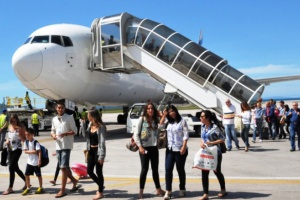First IMF review describes Seychelles economy as ‘strong’ despite weakened currency
Finance |Author: Hajira Amla | December 15, 2014, Monday @ 15:18| 7272 views
Tourists arriving at Seychelles International Airport on Mahé island. It is the weaker demand for tourism - one of the Seychelles principal foreign exchange earners - as well as canned tuna exports that has prompted the IMF to revise its projected growth for 2014 downwards from 3.7 percent to 2.8 percent. (Patrick Joubert, Seychelles Nation)
(Seychelles News Agency) - The economy of the Seychelles is poised to receive another injection of $2.4 million from the International Monetary Fund (IMF) after the island nation successfully completed its first review under the latest Extended Fund Facility (EFF).
According to a recent statement issued by the Bretton Woods institution, the latest disbursement will make a total of around $4.8 million given out by the IMF to Seychelles thus far.
In June, the Executive Board of the IMF approved a three-year total arrangement of a $ 16.8 million arrangement under the Extended Fund Facility for the Indian Ocean archipelago of 90,000 inhabitants.
The disbursements are subject to semi-annual program reviews of the reform programme by the IMF.
According to the IMF, Seychelles’ implementation of the programme in conjunction with its economic fundamentals were deemed “strong” despite a weakening of the country’s external position halfway through the year.
“At the first test date of end-June 2014, all performance criteria were met; based on preliminary data, all third quarter indicative targets were also achieved,” read the statement.” The structural agenda remains broadly on track, although there were some technical delays, notably with respect to amending tax legislation to make it consistent with international transparency norms.”
Slower growth due to devalued currency
The IMF has revised its projected growth for 2014 downwards from 3.7 percent to 2.8 percent, due to weaker global demand for Seychelles' two principal foreign exchange earners—tourism and canned tuna.
A rise in personal earnings and the availability of private sector credit have fueled a surge in imports to the island nation, placing increased pressure on the balance of payments.
As a result, the exchange rate in Seychelles depreciated by 11 percent from early August until the end of October.
The IMF have described the Central Bank of Seychelles (CBS)’s decision to tighten the reserve money target for the fourth quarter of the year and maintain this stance into 2015 as a “strong response” designed to dampen inflationary second-round effects of the depreciation.
“The flexible exchange rate regime continues to serve the country well, and can act as an important safety valve in helping to manage the pressures and restore external equilibrium,” read the IMF statement.
Slow but steady progress
The IMF went on to praise the Seychelles government’s “steadfast implementation” of the structural agenda to ensure greater transparency and efficiency in the use of public resources, strengthening the governance of state-owned enterprises, and enhancing the environment for private sector development.
In 2008, the Indian Ocean island nation’s total public debt stood at 151 percent of GDP with external public debt representing almost 95 percent of GDP ($808 million).
The majority of the country’s debt was owed towards Paris Club creditors, and the inability to meet the debt repayments prompted Seychelles President James Michel to embark on a five-year IMF-backed economic reform programme in October 2008, ending in October 2013.
In March 2014, following the visit of an IMF mission to Seychelles, the IMF mission chief for Seychelles, Marshall Mills, announced that the Executive Board would consider proposals for the international financial institution to support a new generation of reforms for the Seychelles in June.
The resultant EFF programme currently in place is aimed at reducing the country’s high debt levels while at the same time strengthening macroeconomic stability, reducing Seychelles’ vulnerabilities, and supporting wide-ranging structural reforms for sustained and inclusive growth.
The Seychelles government has pledged to bring the country‘s public debt to 50 percent of GDP by 2018. In October, the finance ministry confirmed that Seychelles’ debt-to-GDP ratio had declined to 63 percent – 33 percent external debt and 30 percent domestic debt – as at the end of August 2014 compared to 77.5 percent of GDP in 2012.
Back
